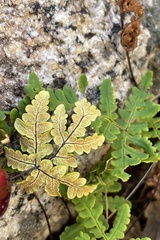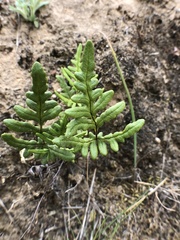Observations of the Month: Pentagramma (Pteridaceae)
California Goldback Fern (Pentagramma triangularis)
https://www.inaturalist.org/observations/76083143 by @madily

Silverback Fern (Pentagramma viscosa)
https://www.inaturalist.org/observations/76669765 by @rachall

Rebman Silverback Fern (Pentagramma rebmanii)
https://www.inaturalist.org/observations/41138197 by jrebman

San Diego Silverback Fern (Pentagramma glanduloviscida)
https://www.inaturalist.org/observations/74211983 by jrebman

Goldback and silverback ferns of the genus Pentagramma are adapted to dry conditions and are found only in western North America. Since 2015, the genus has been represented by six species, four of which (Pentagramma triangularis, P. viscosa, P. rebmanii, and P. glanduloviscida) have been documented in San Diego County by voucher specimens held in the San Diego Natural History Museum’s herbarium. A fifth species, Pentagramma maxonii, is thought by some to be present but lacks a voucher specimen to support its presence in our county. The sixth species, Pentagramma pallida, occurs in the western Sierra Nevada foothills and is not found in our area.
As the common names suggest, to distinguish among these species, the color of the underside of the frond is an important characteristic. Of the four species documented in our county, only Pentagramma triangularis is a “goldback fern” with the underside of its fronds yellowish. The color is from a substance excreted by the plant, sometimes referred to as an exudate or as farina. But the color of the underside of a frond is not the only feature you need to consider and capture in your photos when you post an observation of a fern in this genus to iNaturalist. Other important features include the topside of the frond and the overall shape and size of the fronds and their leaf segments. The topside of the fronds of P. triangularis are smooth (glabrous/without glands) or rarely with only sparse yellow farina. Pentagramma triangularis is widespread, found in our county in all regions except the desert, and is also found in other parts of western North America.
Since the other species found in Southern California (including P. maxonii) are all “silverback ferns” with the underside of their fronds whitish, additional features must be examined to tell them apart.
Pentagramma rebmanii has sparse white farina on the topside of the frond. A close-up photo of the topside of a frond, along with photos of the underside and of the plant overall, should be taken to identify P. rebmanii from photos. This fern is found only in San Diego County (roughly from Santa Ysabel south, in the foothills and mountains) and in northern Baja California.
Pentagramma viscosa has a sticky resinous surface on the top of its fronds, which may not be evident in a photo. However, P. viscosa differs from the others in the shape of the lower-most segments at the base of the leaf, near the leaf stalk. In P. viscosa, these segments are entire or nearly so while in the others they are divided or lobed. Photos showing both the top and undersides of the fronds and the shape of the segments should always be included for observations of this species which occurs close to the coast and into the inland valleys in San Diego and other parts of Southern California and Baja California.
Pentagramma glanduloviscida has stalked yellowish glands on the top surface of its fronds, but unlike P. maxonii the glands are smooth and lack protuberances. The fronds of P. glanduloviscida are generally longer than they are wide. In P. maxonii, the fronds are approximately as wide as they are long, and the glands on the top surface have small protuberances visible under a microscope. Always try to include a close-up of the top surface with enough resolution to show the glands in addition to photos showing the underside of the fronds and the overall shape and size of the leaflets for observations of these species. Pentagramma glanduloviscida occurs in our county from the coast to the foothills. Pentagramma maxonii has been documented in desert areas of New Mexico, Arizona, California, and Sonora, Mexico, but as noted above, it has not yet been documented in San Diego County by a voucher specimen. Previously, the plants now known as Pentagramma glanduloviscida were called Pentagramma triangularis ssp. maxonii. In the 2015 paper in which Pentagramma glanduloviscida was newly described, Pentagramma triangularis ssp. maxonii was elevated to Pentagramma maxonii. You will still see Pentagramma triangularis ssp. maxonii on older checklists of San Diego plants and on voucher specimens collected in San Diego County before 2015 but based on the distribution of the two species, the San Diego plants are P. glanduloviscida.
As with most plants, when posting observations to iNaturalist, multiple photos are needed to reveal the relevant characteristics of ferns in the genus Pentagramma. For additional information about plants found in San Diego County visit the San Diego County Plant Atlas website: http://www.sdplantatlas.org/



